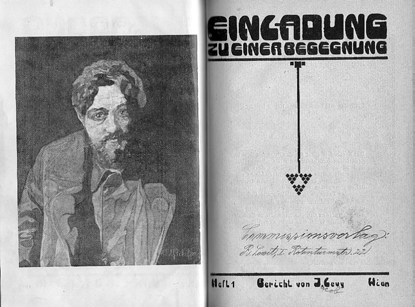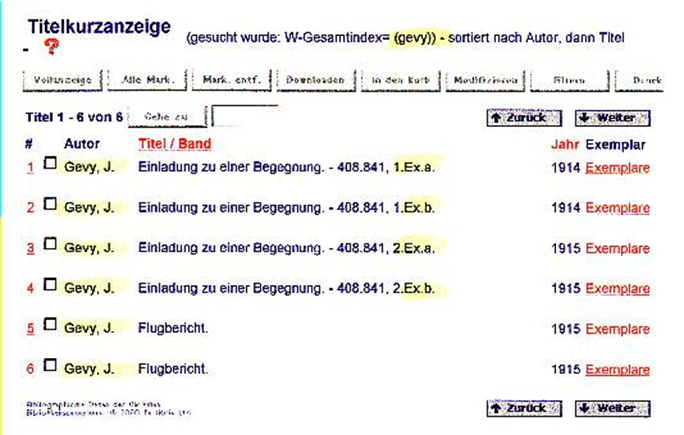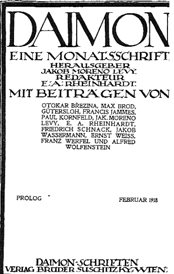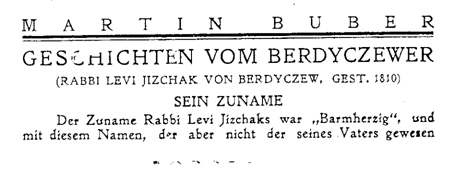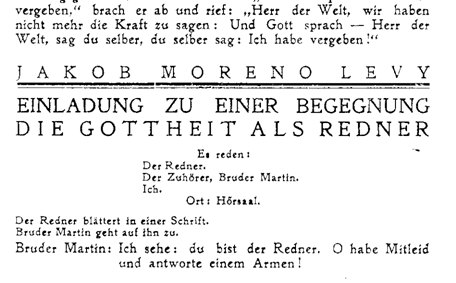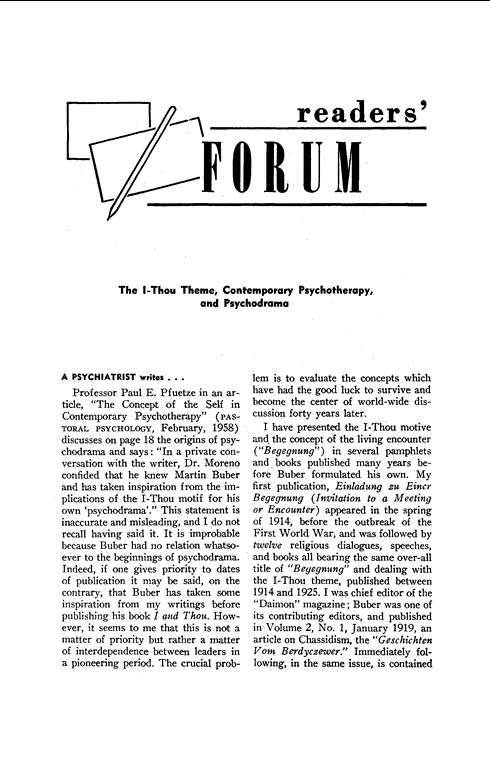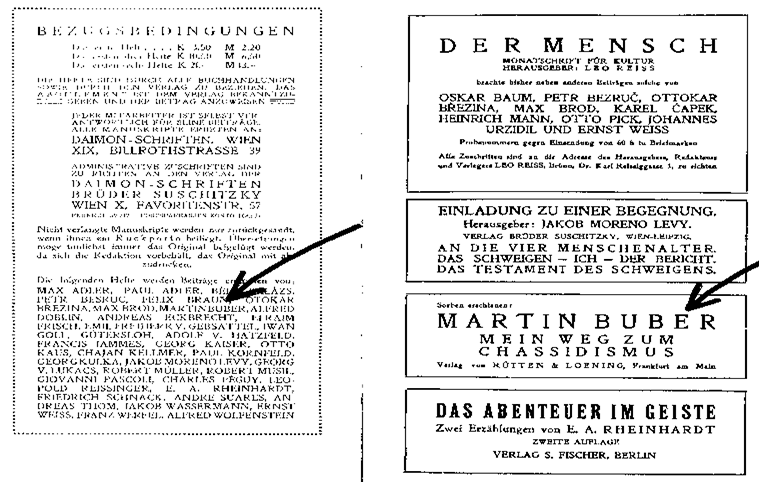J.L. MORENO’S INFLUENCE ON MARTIN BUBER’S
DIALOGICAL PHILOSOPHY
Robert Waldl (Vienna, Austria)
with comments by Adam Blatner
Robert Waldl, below:
|

|
Posted, February 2010. (Presentation at the 62nd Annual conference of
the American Society for
Group Psychotherapy & Psychodrama (ASGPP), in April 2004 and also
at the 63rd conference in Miami, April, 2005).
Also published as:
Waldl,
Robert.
(2005). J. L. Morenos Einfluss on Martin Bubers Ich und Du. (J. L.
Moreno’s influence on Martin Buber’s I and Thou). Zeitschrift für
Psychodrama und Soziometrie, 1,
169-173. German. English
abstract. Also on internet in German as:
http://www.waldl.com/downloads/Waldl_Morenos_Einfluss_auf_Bubers_Ich_und_Du.pdf
Before showing and discussing my
findings, I would like to introduce
myself and give you a short description of the way of my work. I am a
person-centered psychotherapist in Vienna (i.e., mainly influenced by
the pioneering work of Carl Rogers.). Five years ago I went back to the
University of Vienna to study philosophy, and in 2002 I wrote my
Master’s thesis titled The Therapeutic Aspects of Martin Buber’s
Philosophy. The last chapter of my thesis was focused on Buber’s
influence on the different schools of psychotherapy. With regards to
this topic I read books about J.L. Moreno and
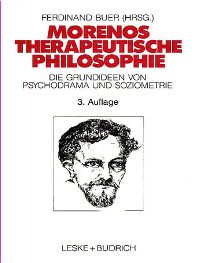
|
psychodrama. At first
sight things seemed to be clear: In a number of papers and books in the
professional literature, Moreno is viewed as influenced by Buber—or so
it seemed. For example, Ferdinand Buer, the author of Moreno’s
Therapeutische Philosophie (1999, page 26), wrote, “First of all Martin
Buber, who worked from 1916 to 1923 partly in Vienna on his Philosophy
of ‘I and Thou’... has influenced Moreno strongly.”
But Moreno said that it was he who influenced Buber! Who was right?
Others have said that Buber’s philosophy influenced other founders of
psychotherapeutic schools such as Laura and Fritz Perls and Victor
Frankl. However, in one of the textbooks I found a quotation by Moreno
about encounter from 1914, (quoted in a textbook for modern Methods of
Psychotherapy 1994 (Hilarion Petzold (HG.),
Wege zum Menschen, Methoden
und Personlichkeiten ), and this puzzled me strongly. This poem is
published by Moreno several times, it plays a central role. Please let
me translate it to you later. Prof. Dr. Petzold interpreted this poem
(roughly translated): We can easily see that these lines of
Moreno are
corresponding with Buber's concept of “I and Thou.” And in fact the
connection from these lines to Buber cannot be denied.
However, what
absolutely does not fit here is the year 1914.
Because I was very familiar with Buber’s writings due to my studies,
and I remember very well my thoughts when I was reading this words
from Morenos early poems for the first time: "If Moreno was influenced
by Buber already in 1914, then he must have seen texts by Buber which
I have not seen yet!" (In other words, I knew of no writings by Buber
about encounter before 1920.)
At that point, by coincidence someone else gave me an interesting lead:
Because my thesis was funded by a Victor Frankl scholarship, I had the
opportunity to meet Mrs. Eleonore Frankl, Viktor Frankl's widow. She
found and gave me copies of letters from Moreno, Pfuetze and Buber.
When I saw this poem from 1914 for the first time, these copies
where
lying yet unread on my table. In this widely unknown collection
of
letters published in the journal,
Pastoral Psychology ( which I started
re-reading), Moreno wrote 1958 what sounded to me at the same time
absolutely amazing and however very logical: He wrote that it was he
who influenced Buber’s writing of I and Thou with his early writings
which were published nine years before Bubers main work!
I went to my Thesis-Professor Dr. Klaus Dethloff to show him my
findings. I still remember him turning the copies and the books around
and around saying, “This is very exciting; you have to stay on that.”
And so I did. The problem was that in 2002, it was not possible to find
all the early writings of Moreno in the Austrian Libraries. I couldn’t
believe that Moreno should not have left more copies of his writings in
the big Libraries of Vienna and I started searching deeper. It turned
out that six copies of Moreno’s Writings had been lost in the Library
of University of Vienna.
The problem was that Moreno’s name at that time was Jacob Levy—he added
the “Moreno” later! Here you see the first page of a booklet of Moreno
from 1914 and you see that a librarian missed a few things on it. So
someone added the name of the publisher
by handwriting and the “J” is
correctly completed to Jacob”—but then a mistake occurred and this
booklet and five others got lost in the system of the library for a
long time. The librarian could not read the name “Levy” properly, saw
the “L” as a “G,” and so these booklets were categorized under the name
“Gevy” until I found them! I found them by checking thousands and
thousands of books under the keyword “Begegnung” which means encounter.
(Hooray for computers!)
Found 2002 in the Library of the University of
Vienna: “Gevy” is Moreno!
No unknown writings, but 6 unknown copies of three different booklets
published by Jakob Levy 1914 -1915. Shown here is the list of the
search-result from 2002 from the Library of the University of Vienna.
The Computer listed six books from the unknown author Gevy, who in fact
is Moreno. By this way I did not find unknown writings by Moreno, but I
found six copies of three early publications which had not been
available for scientists for many years.
The German word “Begegnung” means encounter or meeting and it is not
only the right keyword to find Morenos books, it is the keyword to the
whole Moreno-Buber issue!
The main question for eventual influences in either one or the other
direction, then, is what did Moreno write and what did Buber write and
when? In 1914 and 1915 Moreno wrote expressionistic poems, short
texts
and published them in small booklets all under the same title:
“Einladung zu einer Begegnung,” meaning “Invitation to an Encounter.”
For differentiation he gave his texts different subtitles.
These Invitations to an Encounter were not only meant as literature, it
was in fact meant as an invitation to meet people. In the first booklet
Moreno published, he announces an address where he could be contacted
and letters and invitations could be sent to. In the next booklet
Moreno got more concrete and writes, he only will consider letters
which intend a direct encounter face to face. (AB: Nowadays we
use a
webpage!)
The central- the main- and over all issue, which dominates every page
of his booklets is the living Encounter: Moreno writes about encounter
by talking. He describes encounter by meeting in silence face to face.
He writes about encounter by glances. Moreno formulated in an
expressionistic style. His poems are written in archaic, powerful,
strong words. Some lines are almost hurting and others are sensitive
moving. Not all poems are easy to understand. For Moreno these booklets have been very important. As we know from
advertisements he sold them in Vienna for at least six years.

|
The poem I showed you in the beginning is published in these first
booklets and he will repeat these lines a few times almost like a
credo. These five lines are a mystery - they stay in the centre
of the
Moreno-Buber issue. Till now these lines have seemed to be proof that
Moreno was influenced by Buber. These lines are so much concentrated.
If someone would get the job somehow to formulate “I and Thou” in a
poem, these lines would do that very much. These lines will appear later again when we have a look at Buber’s writings.
1918 when Moreno was working as a doctor in Bad Voslau, a little town
close to Vienna, he had obviously better financial possibilities, he
started to publish the magazine Daimon, which was one year later called
the New Daimon and another year later Die Gefuhrten. This journal, with
its various titles, became the magazine of the Austrian Expressionists
and Moreno gathered the most important writers of this
literature-style.
Here Moreno publishes his poems and texts from 1914 and 1915 again. But
he also started to publish longer texts, and plays on new topics.
In
the dialogue of these plays he starts asking very consequently under
which conditions living encounter can take place and what are the
conditions which avoid the direct encounter.
Moreno is reflecting the role of scientists, of authors, of speakers,
of theatre-people in relation to a possible living encounter. He
wrights in vivid words writes about love, about healing, about
relationship.
When did Martin Buber develop his Dialogical Philosophy?
Buber made different statements on the genesis of I and Thou. In the
1920s he mentioned several times an early plan for I and Thou, claiming
the seeds had begun in 1916. In the 1950s Buber wrote on two occasions,
“I report that the idea of ‘I and Thou’ has already been expressed, in
the same terms, in my early writings ... 1907.” Buber himself gave us
two different versions about when he wrote ‘I and Thou.’ He mentioned
several times that he had an early plan for the book in the year
1916.
This is actually the official version and the so called early plan is
referred to in every Buber Biography till today.
My research shows
that, yes, there are plans, but mostly they are from the early 1920s,
as Rivka Horwitz, an outstanding Buber-specialist could show in her
work Buber’s way to I and Thou. The earliest sketch, which could count
as plan for I and Thou is from the year 1918.
1918: earliest dialogical lines from Buber ( out of Rivka Horwitz,
äBubers Way to I and Thou”, 1978) The important terms
“Iö, “Thouö and
“encounterö are still missing in Bubers thinking at February 1918.
But
here Buber still does not use the highly important terms “Iö,
“Thouö or
“Encounterö. Of course someone could think now, maybe there was a
plan
from 1916, which just was not found. So let us shortly have a look what
was Bubers thinking and writing about - in the time before 1918.
Buber was 14 years older than Moreno. Beside his new interpretations of
the Hasidic Legends Buber wrote culture-historical essays. Here his
point of view was mystic and not dialogical. Buber thought in a mystic
way that the crisis of the society could only be solved by a mental
revival in our inner self. Buber was occupied by the inner mystic
experience of the single person and did not have the perspective of
encounter and dialogue. The writer Buber produced highly
aesthetic
essays about the crisis of the culture and his thinking was
non-political and non-social. This attitude of Buber culminated in a
very delicate position about World-War I, which he welcomed as magic
and powerful for a long time. In dark and weird words Buber writes
about the war. He defends the right of Germany to invade and occupy
other European countries. In his mystical understanding the war would
lead to a better society and he brings similarities with wars mentioned
in the Torah.
1916 Gustav Landauer a German Anarchist and an important friend of
Buber, prohibited him any more public statement to the continuing
World-War. Buber came in a real crisis. Later in his life Buber himself
describes this time as a “Self-Correctionö, but the real
background is
not mentioned in the Buber-Biographies. I mention this, to show that
there was no dialogical thinking and no dialogical terms at all during
that time in Bubers writing.
After 1916 Buber changes. Influenced by Landauer he formulates
anarchistic and other social romantic ideas himself. In May 1918 Buber
hold a speech in Vienna, where he describes Jesus as an Anarchist who
fights against Rome. This speech from Buber was announced months
before. During this visit in Vienna he most probably met Moreno for the
first time, because then a publishing cooperation began which lasted
for a long time.
DAIMON, No. 3, June 1918 : The long continuing cooperation from Moreno and Buber is here
documented the first time. Bubers Advertisement is right below the announcement of Morenos
äEinladung
zu einer Begegnung”
Buber never mentioned that he met Moreno. Moreno writes in his
biography that they met in the famous coffeehouse Cafe Museum in
Vienna. A man like Buber surely had a very close look at the magazine
where his writings were published. However, Bubers books were
advertised from now on in Moreno’s magazine and a publication is
announced. By the way, the advertising for Bubers book is right under
the advertising for Morenos booklets “Einladung zu einer
Begegnungö.
DER NEUE DAIMON, 1919
Martin Buber published a Hasidic legend in DER NEUE DAIMON, January
1919 which ended on the same page where Morenos äEinladung zu
einer
Begegnung” begun. The inter-personal relationship appears in Buber’s
thinking 1918, when he was somehow in contact with Moreno. Only once before that - in the year 1906, when Buber was writing a
foreword for a sociological publication he used the term das
Zwischenmenschliche what means interpersonal, but he did not come to
any dialogical meaning of this word. After this isolated use of this
word the interpersonal relationship disappeared in Bubers
thinking for
thirteen years.
I am not the first one who saw the sudden emerging of the topic
"encounter" in Bubers writings in the year 1918. Paul R. Mendes-Flohr,
an outstanding Buber¡scientist writes that 1918 something must
have
reminded Buber on his foreword from 1906 and he realized the importance
of encounter and inter-personal relationship. I think it is possible to
see now how Buber was reminded and made it possible for him to break
through to his dialogical thinking. Considering that all, we can say there can't have been a plan for I
and Thou in 1916 because there was a complete different thinking
then,
and Buber absolutely did not have the terms to formulate something we
could call such a plan.
But than of course the second later version about the genesis of
I and
Thou also is doubtful. In the essay about the history of the dialogical philosophy, Buber
writes 1954 that he formulated the idea of
I and Thou
already in
the
same terms 1907. This statement can only be seen a legend. It is
apparent to me that Buber formulated his dialogical thinking in all his
terms in the year
1922, when he wrote his famous book
I and Thou and not one year
earlier.
1958 Buber was confronted with the statement of Moreno, which I showed
you in the beginning. Here Moreno writes very detailed and in clear
words, that he can't be seen as influenced by Buber because his
booklets were published 9 years before Bubers
I and Thou. Dr.
Pfuetze
a Professor for Philosophy in Georgia sent this statement to Buber the
Professor in Jerusalem. As far as I know, this was the only situation
when Buber was asked how it really was. Buber answered to Pfuetze very
shortly, that he did not know Moreno's writings, and that he only read
one text by Moreno, which he didn't understand. Then Buber
repeats his
own legend and claims again that he had formulated his ideas for
I and
Thou already 1907.
So, as a preliminary summary, the interpersonal relationship appears in
Martin Bubers thinking 1918 (1906 there was an isolated use of the term
“das Zwischenmenschliche," without a dialogical meaning) ; and there is
no dialogical work before I and Thou, which was written 1922 and
published January 1923
- - - -
Let me now summarize the time course of Bubers way to dialogical
philosophy and then show further details.
What Buber received from Moreno: In
I and Thou
we find four different kinds of influence by J.L. Moreno: that will be
explained in greater detail further on: 1. influence in important
ideas; (2) Buber used some of Moreno's phrases and significant terms;
(3) the architecture (of the first two chapters) of
I and Thou; and (4) Bubers unpublished motto of
I and Thou. We can find 4 different kinds of influence from Moreno in Bubers book
“I and Thouö, which I will detail now. There is an influence
in
central ideas. In a few points we will see that Buber took over whole
phrases from Morenos early writings and we can see parallels in the
significant use of terms. Then we can see similarities in what I call
the architecture of “I and Thouö. At last I will show Bubers motto
of
“I and Thouö, which he decided not to publish.
What Buber received from Moreno:
Central Ideas:
- living encounter/unmittelbare Begegnung
- encounter is limited in the time
- healing by encounter
- here and now
-
presence and past
To the first point: Buber received from Moreno central ideas for his “I
and Thouö. The main topic Buber found in Morenos early texts and
poems
is the living encounter. Buber did not only find the term living
encounter with an excellent formulation. He took
from Morenos writings also a few significant contexts of
encounter. Moreno wrote that encounter is limited in time, the
same we find in
Bubers “I and Thou. Moreno writes about healing by encounter, same does
Buber in his book.
Moreno writes about responsibility, which someone has who invites to an
encounter. We find similarities in Bubers book. Moreno shows his
preference to the here and now, which we can also find
in I and Thou.
In June 1918 the papers in the earlier edition were mentioned again as avaliable as books.
The principle in all this points is the same: Buber found these
thoughts in Morenos poems and plays and formulated it far more detailed
in his book. Some
of this ideas Buber found in very a significant formulation in Morenos
writings. Buber took some phrases from Moreno almost word by word:
Es gibt kein Mittel zwischen äDie
Beziehung zum Du ist mir und anderen / Ich bin unmittelbar. ... Alles
Mittel ist unmittelbar: in der Hindernis. Nur wo alles Mittel
Begegnung” zerfallen ist, geschieht
Begegnung.”
MORENO 1914, MORENO 1915, MORENO 1918 BUBER 1923, I and Thou”
These words Moreno repeated This text from Buber is quoted like his
credo. very often in the German textbooks for psychotherapy. Here we
have the lines again, which we saw twice before now. Remember
that these line till now are the proof for influence the other way
round. The young Moreno was a gifted writer and came to such a genius
phrase, that Buber could not avoid to take it over almost word by word.
It is nearly unbelievable ironic but true, that one of the best known
Buber-quotations in the German language must be seen as a
Moreno-quotation in fact.
Unfortunately the genius of Morenos poem will get lost in a
translation, but I will try: Word by word it says: There are no means between me and others / I am actual in the
encounter.
It could mean: There is nothing between me and you / I am real in the encounter.
Moreno used a double meaning of the word “unmittelbarö in such
accurate
way, that Buber could simply not resist to take it over.
“Unmittelbarö
means today immediate and direct. In an etymologic much older meaning
the word “unmittelbarö means there is nothing in the middle so it
says
there is nothing between two people if they meet “unmittelbarö.
Moreno
let this term corresponded with the word “Mittelö, which means
methods
or means, so “unmittelbarö gets the meaning without methods. Buber
rearranges the words and makes the sentence longer, but he uses the
same, very significant meaning.
This significance is the reason why this Buber-quotation got so
attractive for psychotherapists. These sentences from Buber are famous
and used quite often in German textbooks. Actually this quotation was
one of the reasons why I started to work about Bubers dialogical
philosophy.
There are even more phrases with a significant use of terms Buber took
from Morenos early writings.
äIch bin nicht einzig: blo▀ in äGute und B÷se, Kluge
und
der Begegnung / ob ich ein T÷richte, Sch÷ne und
Gott, ein Narr oder ein HΣssliche, einer um den andern
Dummer / Ich bin geweiht, wird ihm wirklich und zum Du,
geheilt, gel÷st in der ... einzig und gegenⁿber
Begegnung” wesend, ... und so kann er wirken, kann helfen, heilen,
-- MORENO 1914, MORENO erziehen, erheben, erl÷sen.”
1915, MORENO 1918
BUBER äI and Thou”, 1923 :
I try to translate what Moreno wrote:
I am not unique: only by encounter / If I am a god
or a fool / I am consecrated, healed, freed by encounter.
I try to translate Buber:
Good and bad, wise and fools, beauties and beasts / one after an
other becomes real and a Thou, / unique and opposing / and so he
can help, heal, educate, increase and free.
The significant words which are identical are: single, fool, healing
and freeing. In the German language Bubers text appears like a resonance. For me it
feels like
this gets lost in the translation. We see the same system. Buber formulates the sentences longer by making
a more detailed prose from the short accurate poem.
- - -
more phrases in Bubers “I and Thouö inspired by Morenos early
writings: Moreno describes encounter: Buber describes encounter:
"Wo ich aufgehe, dort ist dein Himmel” ä... nachbarlos
und fugenlos ist er Du und fⁿllt den Himmelskreis.” -- MORENO 1915 BUBER äI and Thou”, 1923
more phrases in Bubers “I and Thouö inspired by Morenos early writings:
"Wir sollen uns nicht wollen, ä... da gebe es kein eigenes
sondern finden.” Wollen,” --BUBER äI and Thou”, 1923 MORENO 1914, MORENO 1915, MORENO 1918
-Das Du begegnet mir von Gnaden û durch Suchen wird es nicht
gefunden.” BUBER
I and Thou, 1923
For time reasons I will not get too detailed with the next examples.
And I must say that these examples are not so spectacular like the
first one I outlined, but we can not miss that there is more than one
significant parallel. The parallels are not always the words themselves
the parallel is the significant use of the words. Both describe the
direct encounter between people in unusual similar words. The point is
Morenos booklets were published nine years earlier.
So what does this mean now? Of course Buber did not find the whole “I
and Thouö formulated in Morenos early writings. Encounter is
essential
for dialogical philosophy, but it is only a part of it. The issues
which Buber found in Morenos writings, are much more detailed in his
book. It looks like Moreno was the initial encounter for Buber to break
through to his dialogical thinking.
When we look at Bubers dialogical philosophy as a building we can see
some very important stones in this building, which Buber received from
Moreno. Without these significant elements from Moreno, Bubers building
of the dialogical philosophy might look very different. However, there are not only single elements Buber received from Moreno.
When we make a step back and look at “I and Thouö we may see that
the
whole architecture of Bubers main-work is influenced by Moreno.
In his texts published in DAIMON Moreno writes about the conditions of
living encounter. In his plays he invents dialogues where authors are
accused by others, that they donÆt want to get in real touch with
people. Moreno calls for persecution of all authors in order to really
meet them. The same happens to speakers and theatre-people. The young radical
Moreno demands to encounter the whole person in the here and now and
not only to call for ears or eyes of an audience. Moreno describes on
one side the conditions which lead to a living encounter and on the
other side the conditions which hinder people meet each other. And this
duality of encounter and non-encounter the book “I and Thouö is
all
about. Buber starts with the words:öTo man the world is twofold,
in
accordance with his twofold attitude.ö and actually he does not
leave
this issue till the last page.
Last but not least there is a significant point even in motto of “I and
Thouö which shows the dimensions of the influence of Moreno on
Bubers
thinking: As we have seen before, the young Moreno was very strict upon
book-authors and said they can not come in contact with their readers
via books. He says the only legitimation for writing only may be a
report from an encounter or an invitation to an encounter. He strictly
differentiated between living encounter and writing about encounter.
Buber did realize although he was writing about living encounter that
he wrote just a book. He tried to get out of this trap by writing a
short foreword, which he called the motto of “I and Thou.” Here he
tried to talk to the readers in the second person singular and started
with following words: You, who is reading here, what you will read here,
is spoken to you. I don’t know you, how may I call you?
The words he used in the motto suggest the writing ideas of Moreno.
Buber didn’t publish this motto. It was found in the unpublished manuscripts of
I and
Thou. I
think Moreno did not know this motto. However if you put Morenos
comment to “I and Thouö beside Bubers writing, an imaginary
dialogue
between Buber and Moreno occurs.
A Final Word:
Let me use Morenos comments from 1959 as a final word: “The author Buber does not talk with his “I" to a
“Thou" of the reader. Buber's “I does not come out from the book to encounter this “Thou." Buber and the
encounter are stuck in the book. The book is abstract and in the third person. It is
an abstraction of the living encounter and not the encounter itself".
Thank you for your attention.
- - - -
Ladies and Gentleman, In the beginning I want to thank the ASGPP for
giving me the opportunity for this presentation about J.L. Morenos
Influence on Martin Bubers Dialogical Philosophy. Furthermore, I thank Mrs. Zerka Moreno very much for encouraging me to
give this talk. Dr. Walld's website is:
www.apg-forum.at

